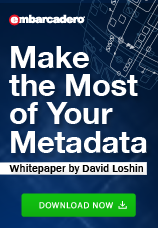I had a recent email exchange in which a customer was looking for guidance in developing data models for master data entities used across multiple business functions and domains. One of the motivating factors was the desire for evolving a “golden record” (a term that makes me bristle each time I hear it, by the way) for each master entity type – a golden customer record, a golden product record, etc.
I expressed my concern about two things: attempting to create a model intended to represent a single version of each entity’s attributes, and developing the model from the bottom-up with a focus on data consolidation rather than being designed from top-down with a focus on business consumption. And while one of the ideas was to start with Universal Data Models (such as those presented by Len Silverston in his excellent data model resource books), attempting to conjure a single model that can be deployed for multiple business purposes presents some specific risks to master data success.

For example, many people attempt to start their “customer” model with a starter model provided by the MDM product vendor. Simple application uses for this starter model are often eclipsed by more complex needs for interoperability, especially as more applications are brought in to adopt the use of the master data environment. Because of this, initial attempts of modeling are overtaken by the incremental accretion of data elements needed to support each next special use case, with the result eventually being a conglomerate model that does not accurately reflect the original vision of the entity.
In addition, in most organizations the master data system is engineered to pull data from different operational systems and periodically merge that data into the master environment. In the absence of managed governance, this periodic merging can introduce consistency and synchronization issues. This seems to be a common failure point, as the master repository just becomes another copy of the same data in the operational systems yet becomes inconsistent with all of them.
Creating a “golden record” should mean that the master environment is the system of record for the full entity data life cycle, and that would imply that the master environment would be fully integrated with the different operational systems in the enterprise. To do this, one would need to do, at the very least, two things:
- Institute a practice for business-oriented data conceptual and logical data modeling.
- Reengineer application interfaces to adapt to specific business-oriented uses of shared master data.
These both require thoughtful design with respect to designing a master model that is consistent with multiple sources, and we will focus on these topics in the next blog post.
______________________________________________________________________________
You can also read this White Paper from David Loshin: Make the Most of Your Metadata
About the author:
 David Loshin, president of Knowledge Integrity, Inc. (www.knowledge-integrity.com), is a recognized thought leader and expert consultant in the areas of analytics, big data, data governance, data quality, master data management, and business intelligence. Along with consulting on numerous data management projects over the past 15 years, David is also a prolific author regarding business intelligence best practices, with numerous books and papers on data management, including the second edition of “Business Intelligence – The Savvy Manager’s Guide”.
David Loshin, president of Knowledge Integrity, Inc. (www.knowledge-integrity.com), is a recognized thought leader and expert consultant in the areas of analytics, big data, data governance, data quality, master data management, and business intelligence. Along with consulting on numerous data management projects over the past 15 years, David is also a prolific author regarding business intelligence best practices, with numerous books and papers on data management, including the second edition of “Business Intelligence – The Savvy Manager’s Guide”.